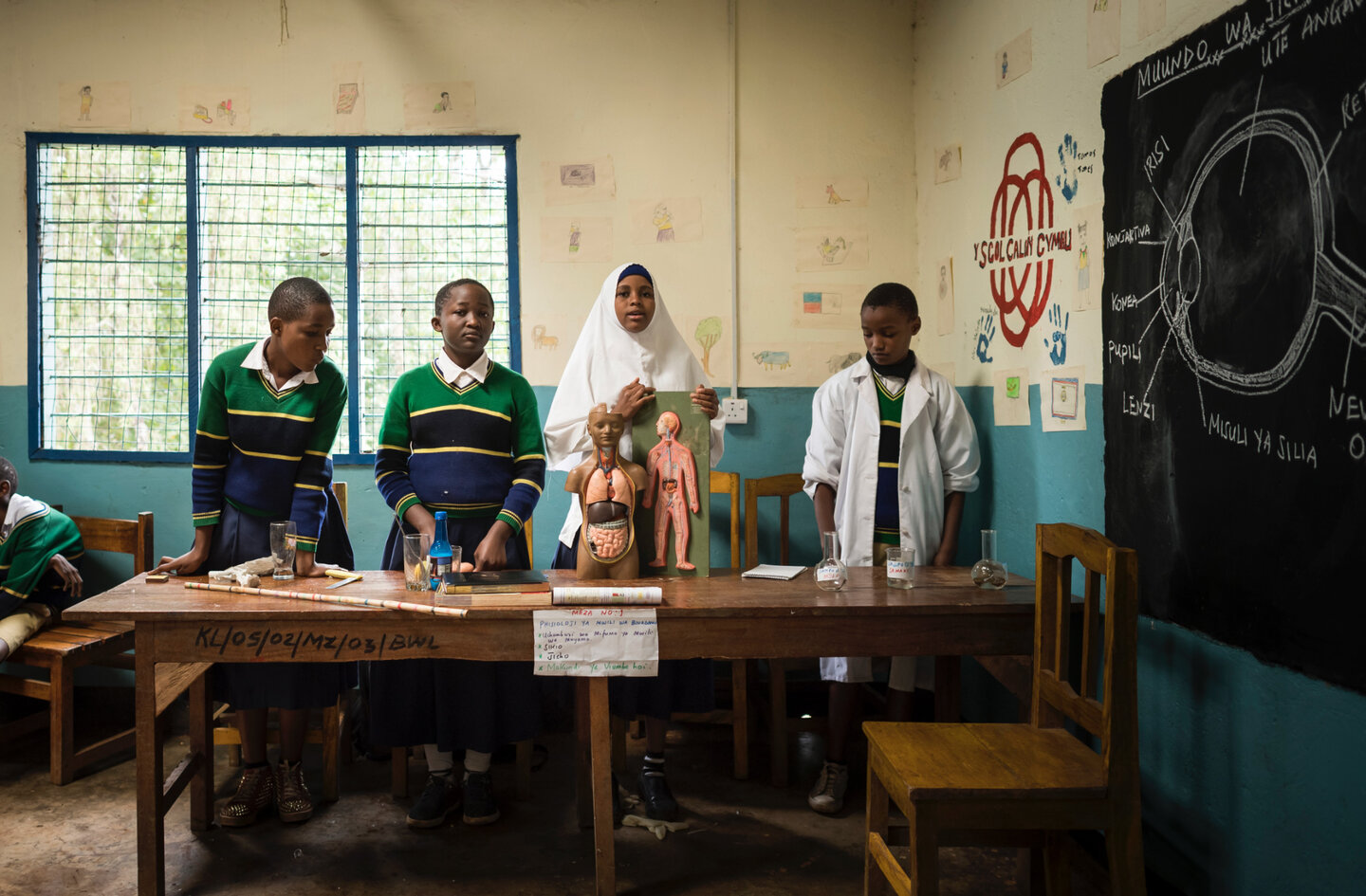Being with Helvetas Tanzania for a bit over a year now as Monitoring and Evaluation Officer, I visited dozens of schools and have been blown away by the positive response to the project and learned about the difficulties for scaling up its approach. This article sheds some light on the learnings we are making while upscaling the approach to teacher colleagues across Tanzania, East and Southern Africa.
From 2016 to early 2022, the SITT project has been very successful in helping teachers in Tanzania become more competent and confident in their work. Despite recent efforts to improve its education sector by the government and non-profits organization, Tanzania’s sector is still facing some challenges: overcrowded classrooms ,and a shortage of teachers are making it difficult for students to get the attention and support they need. There are also issues with accommodating children with special needs, and many teachers are not receiving the refresher training they need to stay up to date with the latest teaching techniques.
In the past 3 years, the SITT project has tackled these challenges and help students succeed. Helvetas and Tanzania Teachers’ Union (TTU) have been working with the Tanzanian government to implement the Inclusive School-based In-service Teacher Training (SITT) project to improve the performance of pupils in the Primary School Leaving Examination (PSLE). The key is to enhance the competences and confidence of teachers and creating a more joyful learning environment for pupils.
The project has been making a real impact in seven regions of Tanzania. 900 teachers across 20 districts have benefited from the project, with 378 schools reached by the project. Moreover 130 schools reached by the district school, 12 teacher colleges, and 31 schools reached by teacher colleges. Due to its successful implementation of the first phase in primary schools, some stakeholders have shown interest in taking SITT Model to the next level by involving secondary schools. Since May 2021 Helvetas is collaborating with the Dar es salaam University College of Education (DUCE), and the other two universities: Kibabi University (KIBU) from Kenya and University of Zambia (UNZA) to replicate SITT Model into 105 secondary schools of which 35 are from Tanzania, 35 Kenya and 35 Zambia in practice-based teaching of Mathematics. This has been done by engaging 21 Teachers Colleges of which 7 are from Tanzania, 7 Kenya and 7 Zambia. In 2022, both Tanzania Teachers’ Union (TTU) and government authorities requested for the project to be extended and implemented in other regions of Tanzania.

Before SITT Project, for couple of years Helvetas was embarking on the project called Quality Education through the Expert Teacher System (QUEETS). This was done in collaboration with the Tanzanian Teachers’ Union and local authorities to establish and advocate for an in-service teacher training with peer-to-peer teaching at school level. Based on the findings and recommendations of the QUEETs evaluation report 2014, which was conducted by Professor Rolf Gollob, Wiltrud Weidinger Center IPE at Zurich University of Teacher Education (PH Zürich), it was discovered that the cascading model particularly expert Teacher (ET) coaching their fellow teachers within schools was weak and mainly because:
-
Teachers expected payment for extra hours attended the class lessons.
-
Some teachers have a side job or needed to do garden or housework for extra income.
To overcome the challenges mentioned above, the evaluation report recommended for the school-based In-service Teacher Training (SITT). This would be a practice-oriented methodology for accomplishing the intended objectives.
The SITT Approach is made up of nine key elements which are, peer learning among teachers, creation of SITT team of teachers in school, the use of local materials as teaching aids, inclusiveness in learning, practice-based teaching and learning, team teaching, model lessons, pupils participation, and creating a healthy environment for learning. It promotes learning among teachers and believe that every teacher is special in their teaching profession. This phase deepen much more in involvements of the administrators including the Head teachers in school to emphases on the cascading effects that is how the SITT trained teacher convey its knowledge to other teachers. The full involvement of Teacher Collages and the Local government Authorities in SITT training will help to support monitoring and mentorship activities as they will embed SITT approach techniques in the assessments of teachers in schools.
Currently, the Project is expanding the SITT model to a new phase and a wider geographical area, by covering 180 new primary schools from 9 districts in 7 regions. This will allow more teachers and schools to benefit from the SITT approach and consolidate the progress made in the first phase. It is exciting to see the impact this project is having and the potential for it to help more teachers and students in Tanzania.

In this phase, the project is involving 8 other Teacher Colleges (TCs) in the scale-up. With this reach, a total of 20 public TCs will have been covered equivalent to 57.15% of all 35 public TCs in the country. These colleges will provide continuous mentorship support to schools and increase capacity to Teacher Collages by training student teachers using the SITT approach, which aims to create better teachers for the future. Moreover, this phase will also involve training for teachers, Tutors, Prtners and government officials, including the Ward Education Officers (WEO), the School Quality Assurance Officers, the District Education Officers (DEO) and the partner TTU Officials, to familiarize them with the SITT approach and finally continue realising their education support even without project. They will be part of the monitoring teams responsible for supporting the project's achievements in all levels.
- Importance of adequate training: As we scaled up the SITT approach, the primary challenge was providing adequate training to teachers. Normally, we use a 5-days training program, which many teachers felt time was insufficient. Teachers felt overwhelmed with the amount of information and were eager to receive more support in their teaching subjects. To address this, our facilitators worked diligently to fill in the gaps and encouraged the formation of peer learning groups among teachers of similar subjects which will give them a room to continue learning by supporting one another in tackling the difficulty topics.
- Importance of refresher courses: Due to lack of a refresher courses, Most teachers lack new teaching techniques as we are aware that our educational curriculum changes, this require our teachers to receive refresher training timely to be able to accommodate the new changes.. By having at least once per year, refresher courses will boost their teaching techniques and remind them on their responsibilities as professional teachers
- Importance of Modal lesson and Team-teaching approach in teaching process: Additionally, from the peer groups work, teachers are encouraged to share the teaching skills and knowledge by conducting model lessons and organising lessons together and teach as a cooperative team. As the fellow teachers get in one’s teaching classroom, they get chance to observe the teaching techniques and adapt the best practices in the own teaching. Teaching together help teachers to enhance each other, clarify their doubts with other teachers and promote collaboration and friendship among teachers.
- Involving teacher colleges: We also emphasized the importance of utilizing teacher colleges effectively to address complex subject matter in specific subjects. This instills to project continuations as they continue imparting such knowledge and skills to new teachers from time to time.
- A new positive perspective on the use of Teaching tools developed from Locally available materials: back then mostly teachers thought that teaching tools were only for purchase, for example manila cards were widely used but with SITT Approach it encourages the teacher in the use of local materials that are around schools and in the communities meanwhile also empower the students and pupils to be part and parcel of the process of making and using teaching aids/ tools while in teaching and learning process. Teaching should be more of the practice by involving the child to be the center of learning and the 80% of the classwork should be done by the students while teachers remain the facilitators.
Tanzania's education system is still in demand for improvement, and Helvetas and TTU still require significant support to ensure that the SITT approach is implemented in at least 70% to 80% of all Tanzanian primary schools. Any stakeholders interested in prioritizing Tanzanian children's education are welcome to contribute to this cause.


